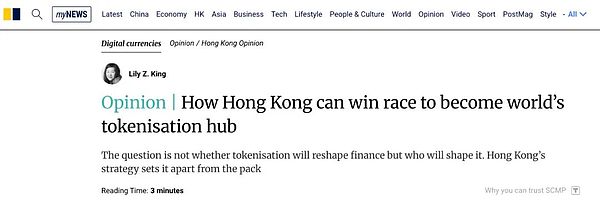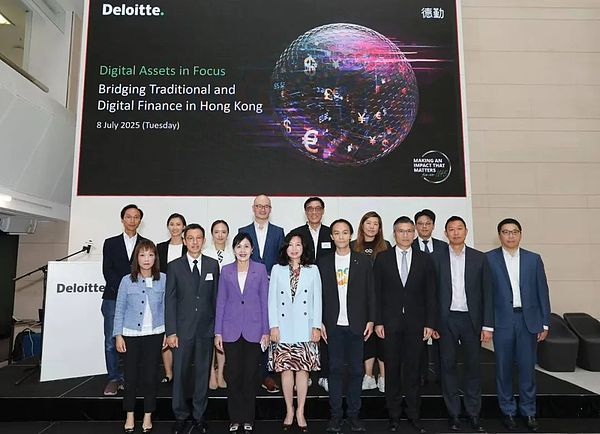Editor's note: The South China Morning Post website published an article by Cobo COO Lily Z. King on July 3, which deeply analyzed how Hong Kong can seize the initiative in the global tokenization competition. The article pointed out that as the tokenization of real world assets (RWA) accelerates into the mainstream, Hong Kong is building a new generation of financial infrastructure with a clear regulatory framework, open market strategy and active policy innovation. In the second half of this competition, the key will no longer be policy guidance, but whether the product really meets market demand.


July 8 Lily Z.King in Hong KongDeloitte Digital Asset Forum
Participants included officials and industry organizations from the Hong Kong Secretary for Financial Services and the Treasury, the Securities and Futures Commission, the Legislative Council and the Hong Kong Monetary Authority
At the heart of this revolution is a concept that was once niche but is now rapidly entering the mainstream: the tokenization of real-world assets (RWAs). Today, more than $24 billion of RWAs are circulating on public blockchains, covering yield-bearing U.S. Treasuries, private credit pools, tokenized commodities and real estate, and more. What was once seen as a “cryptocurrency experiment” is now becoming part of the global financial infrastructure—the underlying pipelines of the capital markets are quietly being restructured.
So the question is no longer whether tokenization will reshape finance, but who will shape it.
In the "Digital Asset Development Policy Statement 2.0" released on June 26, Hong Kong expressed its intention to lead.
The statement launched the "Leap" regulatory framework, expanding the scope of supervision to stablecoin issuers, custodians and RWA platforms. More importantly, it sends a clear signal: Hong Kong is not just "allowing tokenization, but actively advocating tokenization."
"Leap" is an abbreviation for "Legal and Regulatory Simplification (Legal)", "Tokenized Product Expansion (Expand)", "Application Scenario Advancement (Advance)" and "People and Partnership Development (People and Partnership)". It promotes a broader vision by formulating a stablecoin license system, clarifying the regulatory framework for tokenized ETFs, and continuing previous pilots in digital bonds and green finance, encouraging the tokenization of various assets from precious metals to renewable energy infrastructure.
But perhaps the most meaningful change is not what the policy regulates, but how it defines tokenization - treating it as a core pillar of the new financial infrastructure rather than a sandbox experiment. This alone has set Hong Kong apart from other markets.
In contrast, Singapore has taken a more cautious approach - focusing on institutional participation and restricting retail investors; while Hong Kong has chosen a broader and more inclusive path. It allows retail users to participate under the premise of setting clear suitability rules, expanding the potential market space.
Compared with the EU's normative crypto asset market structure and the fragmented regulatory tug-of-war in the United States, Hong Kong provides a more unified, principle-based system that provides innovators and investors with the clarity they need.
However, just laying the track does not mean that the train will run on time. It is easy to issue a tokenized asset, but the difficulty lies in whether there is anyone willing to hold, trade and trust it.
Too many tokenized projects learned this the hard way: the technology was fine, but the market didn’t buy it. Lacking distribution channels, market demand, or real relevance, many products were simply shelved. The bottleneck is not technology or regulation, but whether the business value actually exists. The real test is whether a tokenized asset really solves a problem for a well-defined user group.
Of course, there are projects that pass this test and successfully scale. For example, tokenized U.S. Treasury products have gained widespread adoption among savers around the world because they provide stable and transparent yields, especially in emerging markets that lack safe yield channels.
Another example is that protocols such as Maple Finance have opened up new paths in the private credit field, making products available in both directions by matching institutional borrowers and crypto-native lenders and implementing transparent risk control on the chain.
These successes do not come from new and novel technologies, but from the perfect match of assets, users, and packaging methods.
Hong Kong's local ecosystem is also evolving in this direction. The Hong Kong Monetary Authority's "Project Ensemble" is experimenting with tokenized bonds, funds, carbon credits, charging pile infrastructure and supply chain finance. These projects are promising, but the blockbuster projects that can truly connect the three elements of assets, audiences and usage scenarios on a large scale have not yet appeared.
All the elements are in place, and what is needed next is "market traction". Hong Kong has laid a solid foundation: credible projects with clear supervision, institutional recognition, and public-private collaboration are constantly advancing. Hong Kong is increasingly seen as a safe and well-structured digital asset experimental environment, and its potential as a "bridgehead" for China's digital asset strategy makes its significance far beyond the local market itself.
But the hardest part has just begun. The next stage of competition will be determined by "product-market fit" rather than more policies. Can Hong Kong attract Southeast Asian savers to invest in truly profitable stablecoin products? Can China's industrial assets be connected to global capital through compliant digital packaging? Can a new generation of RWA products that are not only legal and compliant but also have real market demand be incubated?
These questions will determine whether RWA is just a trend or a lasting change; they will also determine whether Hong Kong can become the global tokenization capital of this new era. If successful, Hong Kong will not only be a leader, but also one of the definers of the future financial form.
 Kikyo
Kikyo







